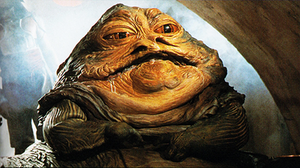Jabba the Hutt facts for kids
Quick facts for kids Jabba the Hutt |
|
|---|---|
| Star Wars character | |

Jabba the Hutt as seen in Return of the Jedi (1983).
|
|
| First appearance |
|
| Created by | George Lucas |
| Portrayed by | Declan Mulholland (Episode IV; deleted scene, later restored and overlapped with CGI for 1997 Special Edition and subsequent releases) |
| Voiced by |
Other:
|
| Performed by | David Barclay / Toby Philpott / Mike Edmonds (Episode VI) |
| Language | Huttese |
| Information | |
| Species | Hutt |
| Gender | Male |
| Occupation | Crime lord |
| Family |
|
| Children | Rotta the Hutt (son) |
| Homeworld | Nal Hutta |
Jabba Desilijic Tiure, usually called Jabba the Hutt, is a famous character from the Star Wars movies. He is a large, slug-like creature and a powerful crime boss. Jabba lives on the desert planet Tatooine. He is known for being very greedy and controlling many illegal activities.
Jabba was created by George Lucas. In the movie Return of the Jedi, he was brought to life by a huge puppet. Later, he was also shown using computer graphics (CGI) in other Star Wars films.
Contents
How Jabba Was Created and Designed
The look of Jabba the Hutt was designed by visual effects artist Phil Tippett. Jabba's body was inspired by real animals like worms. These worms have no bones and can be both male and female. Jabba's head looks like a snake's, with big eyes and a mouth that can open very wide. His skin was made to look wet, like an amphibian. This design became the standard for most Hutt characters in Star Wars.
Bringing Jabba to Life
In Return of the Jedi, Jabba was a giant puppet. It took three months and a lot of money to build this puppet. It was so big that three puppeteers were needed to make it move. This made it one of the largest puppets ever used in a movie.
The puppeteers were David Alan Barclay, Toby Philpott, and Mike Edmonds. They were part of Jim Henson's Muppet team. One puppeteer controlled Jabba's right arm and mouth. Another controlled his left arm, head, and tongue. Jabba's eyes and face movements were controlled by radio control.
George Lucas, the creator of Star Wars, wished that Jabba could have been a CGI character from the start. This is because the puppet was hard to move around the movie set. When the movies were re-released, Jabba was updated to be a CGI character in some scenes.
Jabba's Voice and Music
Jabba the Hutt only speaks a language called Huttese in the movies. His words are shown as subtitles in English. His voice was performed by Larry Ward. To make Jabba's voice sound deep and powerful, it was made lower and given a booming quality. Special sounds, like wet and slimy noises, were added when the puppet moved.
Jabba the Hutt has his own musical theme, created by John Williams. This music is played on a tuba. The theme sounds big and heavy, just like Jabba himself. It helps show how monstrous and powerful he is in the films.
Images for kids
See also
 In Spanish: Jabba el Hutt para niños
In Spanish: Jabba el Hutt para niños







